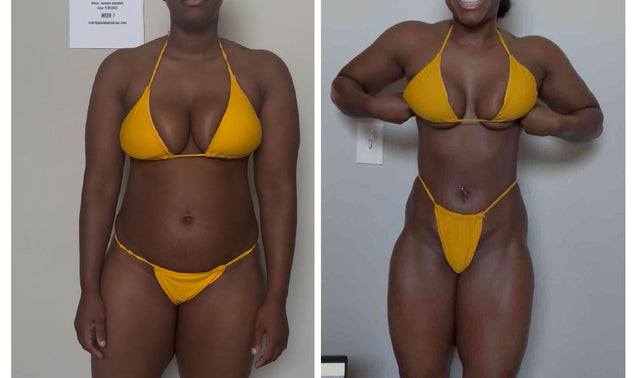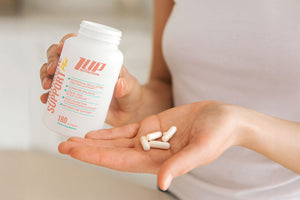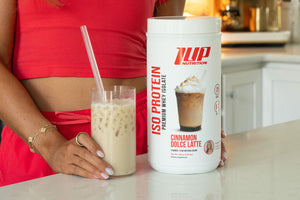When it comes to tracking calories, or rather macronutrients (more specifically), we tend to focus on the three “main” ones -- protein, carbohydrates and fat.
The reason we focus on these is that they constitute the bulk (if not all) of the average individual's nutritional intake on a daily basis (or they should at the very least).
However, there is one other macronutrient that most people tend to indulge in from time to time that can play a key role in whether or not you get the results you’re seeking -- alcohol.
Regarding the intake of alcohol, you’ll hear all sorts of things like “you can’t have a beer and lose weight” or “alcohol ruins your muscle building.” The truth is that you absolutely do not “need” to drink alcohol. There is nothing in alcohol or alcoholic beverages required for survival that you can’t get anywhere else.
At the same time, it’s a gross exaggeration to say that you can’t lose weight, build muscle if you enjoy the occasional adult beverage. You certainly can enjoy an alcoholic drink from time to time, if you so choose, and still get results, just dont over do it.
And that brings us to the topic at hand -- how to track alcohol and still get results.
Let’s start with a breakdown of the calorie contents of each macronutrient.
Tracking Alcohol and Calorie Intake
Weight loss/weight gain always boils down to calories in versus calories out. Just like the other three “main” macronutrients, alcohol contains a certain amount of calories per gram (7 calories per gram to be precise).
Here’s the total energy “payload” of each macronutrient:
- 1 gram of carbohydrate = 4 calories
- 1 gram of protein = 4 calories
- 1 gram of fat = 9 calories
- 1 gram of pure alcohol = 7 calories
If you’re already diligently tracking your calories in the 1UP Fitness App, then figuring out how to track your calorie intake from alcohol isn’t that difficult. Simply enter in what you drank and the app will automatically update your calorie intake for the day.
If you’re new to tracking calories and/or tracking alcohol, don’t sweat it. It’s really pretty easy and takes next to no time at all, especially the more frequently you do it.
As we mentioned, weight loss (as well as weight gain) is all about managing calories in versus calories out.
Based on this, so long as you eat fewer calories than you need to maintain your weight (regardless of what macronutrients those calories are composed of), you will lose weight.
Taken together, you can see how it’s possible to still lose weight (body fat) and still have an adult beverage or two from time to time.
Now, something else to keep in mind is that total calories aren’t the only thing with which to be concerned when dieting to weight loss.
You also want to be cognizant of your daily protein intake.
The reasons for this are many, including that protein helps:
- Keep you feeling fuller than any other macronutrient (including alcohol)
- Causes your body to expend more energy to digest it
- Combats protein breakdown (which can happen when dieting)
- Repairs/builds lean muscle -- the more muscle you have the higher that your metabolism is.
As far as which sources of protein are best for fat loss (or muscle growth), you want to focus on consuming high-quality protein sources that are “complete”, meaning they supply all of the essential amino acids and branched-chain amino acids (EAA/BCAA) the body requires to support protein synthesis and muscle repair as well as resist protein (muscle) breakdown.
Some of our favorite high-quality protein sources include:
- Lean red meat (beef, pork, venison, etc.)
- Chicken
- Turkey
- Cottage cheese
- Yogurt
- Whey protein powder
- Fish (salmon, tuna, cod, mahi-mahi, trout, etc.)
- Shellfish (shrimp, mussels, oysters, etc.)
- Whole eggs & egg whites (including egg white protein powder)
You can also include plant protein sources, including nuts, seeds, legumes, and plant protein powders, such as 1UP Organic Vegan Protein which supplies the full spectrum of EAAs the body needs to fuel muscle growth and repair.
Tracking Alcohol & Calories for Weight Loss
Calories reign supreme for weight loss, and how you divide your daily calorie needs between the various macronutrients can have a significant impact on your body composition, hunger levels, and hormones.
Protein is the most important macronutrient when it comes to optimizing body composition. The reason for this is that protein supplies the body with essential amino acids, which the body cannot produce on its own.
For the reasons we just outlined (and for many others), making sure that you consume enough protein each day is essential. It, for lack of a more sophisticated term, helps prevent you from having the dreaded “skinny fat” look that many individuals get when they adopt an extreme fad diet that has them consuming woefully low amounts of calories and not enough protein.
Once we have protein accounted for, you can pretty much split your calories how you like between carbohydrates and fats. This is a matter of personal preference, really, as some people find they perform better and experience less hunger when eating more fat and less carbs during the day while others are just the opposite.
But, what about alcohol?
Where does it fit into the diet, and/or how do you track it.
Well, if you’re tracking purely total calorie intake, then simply enter in the calories for the drink you’re consuming and that’s all there is to it (track inside 1UP Fitness App).
Now, if you’re tracking macros, you’ll need to decide to which macronutrient to attribute the alcoholic beverage -- carbohydrates and/or fat.
Since a lot of mixed drinks contain a lot of simple sugars, many individuals simple choose to count the whole drink as carbohydrate macros.
Others choose to split it between carbohydrates and fat macros (or all as fats).
How you choose to divvy up your alcoholic drinks across your macronutrient goals is up to you.
Here’s an example of how to track your drink using a nutrition tracking app, such as the 1UP Fitness App:
Let’s say your drink of choice was a glass of red wine. The “standard” pour for a glass of wine is 5 ounces, which contains ~132 calories.
To count your glass of red wine as all carbohydrates, divide the total calorie contents of your 5 oz glass of red wine (132 calories) by 4.
Total carbs from red wine = 132 / 4 = 33 grams
You would then input “red wine” and 33 grams of carbohydrates into your nutrition tracking app.
Now, if you want to count your alcoholic beverage as fat, simply take the total calorie content (132 calories, in this example) and divide it by 9 (since there are 9 calories per gram of fat).
Total fat grams from red wine = 132 / 9 = 14.66 grams
So, in your tracking app, you would input 15 grams of fat towards your daily total intake.
How Many Calories Are in My Alcohol?
As you may have noticed, not every alcoholic beverage in which you imbibe lists how many calories it contains.
This is all the more complicated if you order a mixed drink at a restaurant, because you have no idea how much alcohol and/or mixers (sugar, simple syrup, juice, sweet & sour mix, etc.) the bartender is using.
Speaking in general terms, though, here are some estimates on the calorie contents of common drinks you’ll find:
|
Alcoholic Drink |
Amount |
Estimated Calories |
|
LIQUOR |
||
|
Tequila (80 proof) |
1.5 oz (45ml) |
96 |
|
Gin (80 proof) |
1.5 oz (45 ml) |
97 |
|
Whiskey (80 proof) |
1.5 oz (45 ml) |
97 |
|
Vodka (80 proof) |
1.5 oz (45 ml) |
97 |
|
Gin (94 proof) |
1.5 oz (45 ml) |
116 |
|
Rum (94 proof) |
1.5 oz (45 ml) |
116 |
|
Vodka (94 proof) |
1.5 oz (45 ml) |
116 |
|
Whiskey (94 proof) |
1.5 oz (45 ml) |
116 |
|
Rum (80 proof) |
1.5 oz (45 ml) |
197 |
|
BEER |
||
|
Beer (light) |
12 oz (355 ml) |
103 |
|
Beer (regular) |
12 oz (355 ml) |
153 |
|
Craft beer |
12 oz (355 ml) |
170 to 350 |
|
MIXED DRINKS |
||
|
Rum and Diet Coke |
8 oz (235 ml) |
100 |
|
Bloody Mary |
4.6 oz (136 ml) |
120 |
|
Cosmopolitan |
2.75 oz (81 ml) |
146 |
|
Margarita |
4 oz (120 ml) |
168 |
|
Rum and Coke |
8 oz (235 ml) |
185 |
|
Whiskey sour |
3 oz (89 ml) |
125 |
|
WINE |
||
|
Cabernet Sauvignon |
5 oz (145 ml) |
122 |
|
White table wine |
5 oz (145 ml) |
128 |
|
Chardonnay |
5 oz (145 ml) |
128 |
|
Red table wine |
5 oz (145 ml) |
125 |
Something else to keep in mind is that you can always pull up the 1UP Fitness App which contains an extensive food & drink database allowing for you to track those drinks at the touch of a button.
While you’re in the app, you’ll also be able to see how many calories you have left in the day so you can manage your nutrition intake and continue to hit your goals...even if you have a drink (or two).
Takeaway
Despite what you might hear or see, it is possible to lose weight and/or build muscle while still having the occasional alcoholic drink. The important thing to remember is that alcohol does contain calories, which means it does contribute to your daily energy intake.
Furthermore, alcohol can lower people’s inhibitions, not only on the dance floor, but also when it comes to food intake, meaning when some people drink, they tend to consume a LOT more food (especially high calorie foods -- cheese fries, chicken wings, pizza, etc.) when they drink compared to when they don’t.
Consuming too much alcohol can also reduce protein synthesis and actually accelerate protein breakdown. So, if you know you’ll be having an adult beverage later, it may be a good idea to have a scoop of protein powder or serving of amino acids before you go out. That way you’re supplying your body with all the “raw materials” it needs to support protein synthesis.






